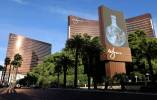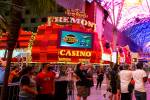2010 Year in Review: Top 10 stories in business
We're big enough to admit when we were wrong.
Did we actually say a year ago in this very space that 2010 couldn't be worse economically for Nevada and Las Vegas than 2009 was?
Yes. Yes, we did.
OK, so state and local unemployment jumped to record levels in 2010. Nevada stayed atop the foreclosure pile as housing prices continued to fall, with no end in sight. More area banks folded, major local projects defaulted on their bonds and several hotel-casinos shut down entire towers and wings to save on the operational costs that come with servicing empty rooms.
But 2010 wasn't all bad.
The market did welcome a new multibillion-dollar Strip resort, and several big energy projects launched with promises to employ thousands of construction workers. Most importantly, several major economic indicators trended upward, with improvements in taxable sales, visitor volumes and gaming revenue toward the year's end.
So maybe we were only half wrong. Or perhaps three-quarters wrong.
Would you believe us if we said 2011 just has to be better?
1. No. 1 and Rising
Well, the good news is that observers in 2010 stopped comparing Nevada's deep recession to Michigan's devastating death spiral.
The bad news? Those comparisons ended because the Silver State blew right past Michigan in a key indicator of economic torpor.
Nevada catapulted to the nation's top spot for unemployment in May, with joblessness surging to 14.1 percent in Las Vegas and 14 percent statewide. The move rescued Michigan from a distinction it had owned for more than four years.
Here's how bad it got: Joblessness hit a record for the 15th straight month in September, rising to 15 percent in Las Vegas and 14.4 percent statewide. By November, the construction sector had lost more than half of its 145,000-worker base. Leisure and hospitality had cut roughly 40,000 jobs. Through the year, nearly 200,000 Nevadans, including more than 140,000 locals, were out of work but looking for jobs.
Unemployment finally eased in October, dropping to 14.1 percent locally and 14.2 percent statewide. It was the first time since 2005 that unemployment in the state had declined from month to month.
But that decrease wasn't an unmitigated bright spot: It came from a shrinking labor force, as 50,000 residents, or 3.6 percent of the state's labor pool, simply abandoned the job market. Nearly 35,000 of those workers were from Las Vegas.
The third quarter brought word of even starker numbers, as the Bureau of Labor Statistics released unemployment figures that factored in discouraged workers who've stopped hunting for jobs and underemployed part-timers who'd rather have full-time positions. The findings? Actual joblessness in Nevada averaged 22.3 percent in the late summer and early fall.
-- Jennifer Robison
2. The good and bad about housing
As miserable as the Las Vegas housing market was in 2010, some positives came out of it.
For one, home prices didn't drop by 20 percent to 30 percent as many analysts had predicted, partly because the "shadow inventory" of foreclosures never materialized. Also, prices had already fallen 25 percent in 2009 and are off by about 60 percent from their peak.
New-home median prices rose about 1 percent during the year to $200,850, while existing-home prices fell 4.8 percent to $120,000, Las Vegas-based Home Builders Research reported.
Secondly, the number of foreclosures slid, though Nevada still leads the nation with roughly one in every 79 housing units receiving a foreclosure filing, RealtyTrac reported.
Another positive was new-home sales, which increased 3,6 percent to 4,976 through November, Home Builders Research reported. Resales decreased 4.2 percent to 38,838, despite getting a boost from the federal homebuyer tax credit that expired in April. The tax credit provided $8,000 to first-time homebuyers and $6,500 to move-up buyers who entered a sales contract by April 30.
The outlook for 2011 remains unsettled. Legal issues emerged in October over "robo-signers," or bank employees who were signing thousands of foreclosure documents without reading and verifying them, which prompted a foreclosure moratorium by major lenders such as Bank of America, JP Morgan Chase and GMAC Mortgage. Analysts said these cases will only clog up a system that already has an estimated 8 million bank-owned or foreclosure-bound homes being held by lenders.
--Hubble Smith
3. Seeing an upturn in gaming, tourism
It couldn't get much worse, could it?
In 2009, statewide gaming revenues plunged 10.4 percent -- the largest single year decline in state history. The number of visitors coming to Las Vegas sank 3 percent.
So 2010 had to get better.
Even with a 33 percent jump in gaming revenues on the Strip during February, people were still cautious about a Las Vegas recovery. The increase was attributed largely to high-end baccarat play, fueled by the Chinese New Year holiday.
When gaming revenues jumped 21 percent in August, however, people started to notice.
Through October, gaming revenues were up 5.4 percent on the Strip. Analysts were predicting the state was headed toward its first positive yearly casino revenue increase since 2007.
The number of visitors coming to Las Vegas was up 2.8 percent through October following eight consecutive months of year-over-year increases.
Independent gaming analyst Jonathan Galaviz said there had been significant optimism about the state's prospects since the summer. October's 16 percent gaming revenue jump on the Strip indicated the gaming industry had stabilized from the losses of the past two years.
"Stabilization does not mean every month will be up; there will be some down months," Galaviz said. "However, the long-term trajectory of both casino revenue and tourism visitation should be positive for Nevada into 2011."
The casino industry faced the same questions heading into 2011 as it faced in 2010, such as, "Would casino patrons be willing to spend more on their trips to Las Vegas?"
Different researchers found that Las Vegas visitors were continuing to restrain their nongaming expenditures and cutting back on their visits.
"There is still some weakness in how people are spending their money," South Point owner Michael Gaughan said during the recent National Finals Rodeo, one of Las Vegas's biggest event draws. "The people who used to come for 10 days are now coming for just five. Those who came for five days are staying for only three."
-- Howard Stutz
4. Cosmopolitan opens
Amid a recession that brought the valley crushing home foreclosures and job losses, The Cosmopolitan of Las Vegas offered a bit of sparkle.
The $3.9 billion hotel-casino opened Dec. 15.
Analysts say the property, which Deutsche Bank AG bought out of foreclosure, needs to distinguish itself from other properties along the Strip.
The Cosmopolitan opened with 5,000 employees and 2,000 rooms; another 995 rooms will open in the summer.
The property opened with 12 restaurants, nine retail boutiques and a 100,000-square-foot casino.
The Cosmopolitan sits on 8.7 acres between Bellagio and CityCenter. It offers a nightclub and ultralounge, a 50,000-square-foot spa, and 100,000 square feet of meeting and convention space.
"We are bringing a new and appealing approach to the market," Cosmopolitan CEO John Unwin said.
Unwin is confident The Cosmopolitan will achieve its goal of setting a new standard for local resorts while earning a decent return on the investment Deutsche Bank made to complete the project.
-- Chris Sieroty
5. Station Casinos bankruptcy
After two years of reorganizing its business and fighting off rivals that sought to acquire its gaming assets at bargain prices, Station Casinos Inc. has put 2010 behind.
The company now expects to emerge from bankruptcy in the new year's first quarter.
Las Vegas-based Station Casinos filed for court protection in July 2009 after being unable to deal with the debt it took on in 2007, when the Fertitta brothers, Frank III and Lorenzo, and Colony Capital took the company private in a $5.4 billion leveraged buyout.
In August, U.S. Bankruptcy Judge Gregg Zive approved a $772 million bid by the group led by the Fertittas for most of Station's assets. Colony and several banks are part of that group.
In a letter to employees, Chairman and CEO Frank Fertitta and Vice Chairman Lorenzo Fertitta stressed that the reorganization would enable "Station Casinos to emerge a much stronger company."
Boyd Gaming Corp., a gaming industry rival, had sought to buy some of Station's assets through the bankruptcy process, but dropped out of a court-supervised auction during the summer.
-- Chris Sieroty
6. Banking crisis
The Great Recession dragged on for another year in Nevada and pulled some community banks down with it.
During the year, regulators shut down four banks in the state, including Sun West Bank and SouthwestUSA Bank, in Las Vegas and Nevada Security Bank and Carson River Community Bank in Northern Nevada.
The good news: These were much smaller banks than billion-dollar institutions such as First National Bank, Silver State Bank and Community Bank that blew up during the previous two years.
The Federal Deposit Insurance Corp. and Nevada Financial Institutions Division issued administrative sanctions against 10 of Southern Nevada's 15 community banks during 2010.
Banks are a reflection of the busted Nevada economy, analysts say. It's hard for banks to make money when their customers are going out of business.
A couple of institutions got good news late in the year.
1st Commerce Bank of North Las Vegas looked like a candidate for failure, but Las Vegas lawyer Jason Awad has agreed to buy it from Capitol Bancorp for a $1 and to boost its capital.
Service1st Bank merged with Western Liberty Bancorp, giving the bank access to $100 million in capital. Western Liberty shares trade on the Nasdaq Global Market (ticker: WLBC). So the bank holding company could raise even more capital through a public stock offering.
-- John G. Edwards
7. Local gaming market struggles
Although much attention has focused on the financial troubles of Strip casinos, the locals market and Fremont Street have also stumbled.
With Nevada's unemployment rate leading the country, Strip employees and other residents that indulge in spare-time gaming cut back. As discounts proliferated on the Strip, Fremont Street lost ground as the venue of choice for people not interested in luxury and its accompanying prices.
The result was several pieces of bad news, including the Plaza announcing it would shut 1,037 rooms and lay off 400 people; the mortgage for M Resort being sold to Penn National Gaming at a substantial discount; and Clark County gaming win except for the Strip running $2.4 billion in the nine months through September, 5.4 percent lower than last year.
On a bright note, the Golden Nugget opened the 500-room Rush Tower in late in 2009. Andrew Donner, the developer for the shuttered Lady Luck, submitted plans for its revival but would not disclose the financing sources.
--Tim O'Reiley
8. World Market Center
The opening of the World Market Center's first two mammoth showroom buildings in 2005 and 2006 appeared to add a big dose of diversification to the Las Vegas economy.
While most of the furniture showrooms in the World Market Center come to life only a couple of times a year for shows that highlight the latest merchandise, those shows draw tens of thousands of furniture buyers. As a result, local business leaders saw the potential to build a design industry independent of gambling or entertainment.
But the economic recession, coupled with an aggressive counterattack by the archrival furniture market in High Point, N.C., caught up with World Market Center this year. Rising vacancies and rent reductions to help retain existing tenants caused the owners to default this spring on $558 million in two mortgages.
The fate of the center, which covers slightly more than 5 million square feet, now lies in the hands of the special servicing agents that represent the investors that hold the two mortgages .
--Tim O'Reiley
9. Commercial market
The buzzword in commercial real estate for 2010 was "distressed," which often came before the word "assets" and best described the state of the industry that many analysts predicted would be the next shoe to fall in the Great Recession.
Las Vegas suffered huge commercial casualties during the year.
Town Square and the World Market Center went into default, the Ritz-Carlton and Casino MonteLago at Lake Las Vegas closed, and vacancy increased in every commercial sector.
Local brokerages reported 24 percent office vacancy, 15 percent industrial vacancy and 11 percent retail vacancy at the end of the third quarter. Rental rates decreased, leaving landlords with less income and struggling to pay off their loans.
Commercial mortgage defaults began ticking up significantly in 2006 and that trend continued throughout 2010. Default rates rose by 9 basis points in the third quarter to 4.36 percent, New York-based real estate research firm Real Capital Analytics reported.
The default rate is up from 3.41 percent a year ago and is nearing the record 4.55 percent default rate of 1992 .
-- Hubble Smith
10. Powering Las Vegas
It's been more than a decade since state lawmakers began requiring Nevada utilities to buy electricity from renewable sources. Despite the mandates, green power and the upgraded infrastructure it requires got off to a slow start in the Silver State -- until 2010.
The year brought fresh ways to link the state's power regions, major developments in smart-grid technology and new renewable plants to take advantage of it all.
The biggest project of 2010? The One Nevada Transmission Line, aka ON Line, which NV Energy is developing with electric developer LS Power. The $510 million line, which broke ground late in the year, will run 235 miles, from NV Energy's Harry Allen Generating Station near Apex to its Robinson Summit substation near Ely. Once it's finished in 2012, ON Line will, for the first time, link NV Energy's northern and southern power grids. The intertie will let the utility bring green power generated in rural areas to the state's biggest cities.
But renewables are only part of NV Energy's clean-power strategy.
The utility launched its NV Energize program, a $301 million smart-meter initiative that will replace all 1.4 million of the state's electric meters with digital versions designed to provide real-time details on electric use. The company installed its first 10,000 meters in October and plans to roll out the rest through 2012 .
-- Jennifer Robison
TOP 10 STORIES IN BUSINESS
1. Unemployment
2. Housing crisis
3. Tourism, gaming struggles
4. Cosmopolitan opens
5. Station bankruptcy
6. Banking crisis
7. Locals gaming struggles
8. World Market Center
9. Commerical market
10. Energy market
Poll: What do you think is the top business story of 2010?
Year in Pictures: Videos & slide shows from the R-J staff
More - Year in Review slide Shows, videos, stories




























